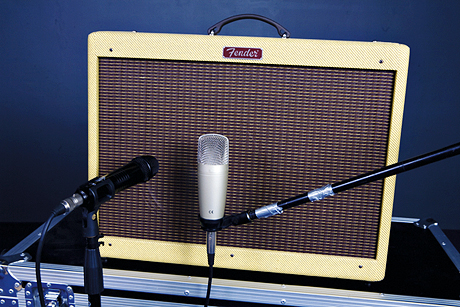Why mic your guitar amp in the first place?

One day you will need to mic up your guitar amp. This is either because it's a small amp and it won't compete with the band, or that it's a big amp and you've just been booked to play your local Enormodome! You might also want to mic up to reduce your on-stage volume as a band, and achieve a nice, balanced and full front-of-house sound, perhaps to preserve your hearing, or because your singer(s) like to be able to hear themselves [just never admit that you're conceding to them! - Band Politics Ed].
The Shure SM57 is the time-honoured and trusted mic for guitar amps; countless engineers and artists still swear by it to this day. It's a unidirectional dynamic mic, and there are many less (and indeed more) expensive me-too mics out there that pay homage to its design. You can use condenser mics too, and if you have a high quality one, there's no reason why you can't use it in a live scenario as well as for recording.
Just do a little experiment: stick a mic on your guitar amp and, while listening though loud headphones, have a friend move the mic to different positions around the speaker - you'll be amazed at the tonal variance.
Set-up 1: Solitary mic

Start by placing the mic three or four inches away from the speaker grille. It needs to be a short distance away from it in order to avoid what's known as 'the proximity effect'; a physical effect on the diaphragm in unidirectional mics, resulting in excess and unpleasant bass. The further away the mic is from the amp, the louder it will need to be set, so you'll also get more of the 'room' sound in terms of sound reflections and extraneous noise.
That might be a good thing or a bad thing, depending on the tone you're trying to achieve. For example, if you have your Fender Vibro Champ sat in the bath for a spot of home recording (electrocution risk notwithstanding), you might want more of the room sound. Conversely, if you're on a belting live stage, you may want less ambient signal.
Want all the hottest music and gear news, reviews, deals, features and more, direct to your inbox? Sign up here.
The distance away from the centre of the speaker towards its edge is very important too. The closer to the cone, the brighter the sound, becoming less distinct as you move towards the edge. "I like to keep it simple," Michael Landau, session ace with well over 500 album credits told us recently. "Just a 57 around an inch off the cone." Who are we to argue?
Set-up 2: Dual mics for versatility

If we bear in mind that the position of a single mic can sometimes be a compromise between warmth and cut, using two mics can offer you much more sonic versatility in a recording environment. When doing this you can either sum the mics to a single stereo channel in your mixer/DAW, or put them on separate mono tracks in order to maximise your control over the EQ, phase issues, effects and so on.
By doing this you can get all the brightness off the centre of the cone with one mic, and use the other one for the fatness of the middle of speaker, and then mix them to taste. Some people choose to mic the back of the amp with the second mic, or use it further away in the room to give more ambient noise.
However, when using two or more mics, the inevitable problem is phasing issues, resulting in a lower, weaker signal at various frequencies.
It's all about experimenting with mic position and also the phase settings on your desk/outboard gear - there aren't really any rules to follow here, just use your ears and go with what sounds best. If you get stuck, go back to basics - one mic, and experiment with position for the best sound.
Guitarist is the longest established UK guitar magazine, offering gear reviews, artist interviews, techniques lessons and loads more, in print, on tablet and on smartphones
Digital: http://bit.ly/GuitaristiOS
If you love guitars, you'll love Guitarist. Find us in print, on Newsstand for iPad, iPhone and other digital readers


